Want to add a unique plant to your collection? The Pilea is a cool option! Here’s everything you need to know about Pilea Peperomioides care!
Ok so I have a funny story about the pilea plant.
I picked up one of these plants kind of on a whim at Lowes. I checked out at the garden center (in January, it was not hopping). The checkout woman picked up the plant, looked at it, and said:
“This looks like a dollar weed. I’m always pulling it out of my yard. And look at you, paying for it.”
She was not smiling or joking. I was honestly shocked and sort of second guessed my purchase, but I couldn’t really back out at that point!
I brought my pilea home and have been enjoying it ever since.
I really like the unique round leaf shape and that it has a different silhouette compared to most of my other houseplants.
More about Pilea plants
- Pilea care guide
- Pilea Dark Mystery Plant Care Guide
- How to propagate pilea from plantlets
- Why are my pilea leaves turning yellow?
- Common pilea peperomioides problems
- How to encourage pilea to grow pups
- What to do if your pet ate your pilea
- Why are my pilea peperomioides leaves curling?
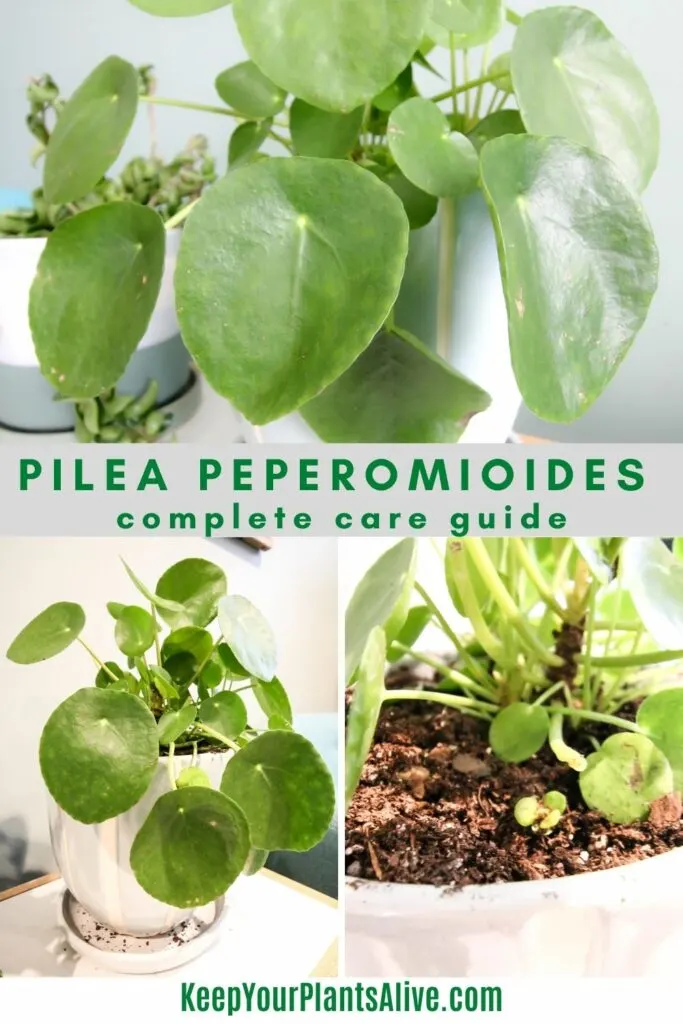
What is Pilea Peperomioides?
Pilea is a cool houseplant with bright green lily pad-like leaves. It is originally from China and was brought by missionaries to Europe.
This is a nice, easy care plant that is very beginner friendly!
Pilea Peperomioides is also known as:
- Chinese money plant
- Coin plant
- Chinese coin plant
- UFO plant
- Friendship plant
- Missionary plant
- Pancake plant
Types of pilea include:
- Artillery fern, P. microphylla
- Baby tears, P. depressa
- Dark mystery pilea, P. ‘Dark Mystery’
- Friendship plant, P. involucrata
- Silver tree pilea, P. spruceana ‘Silver Tree’
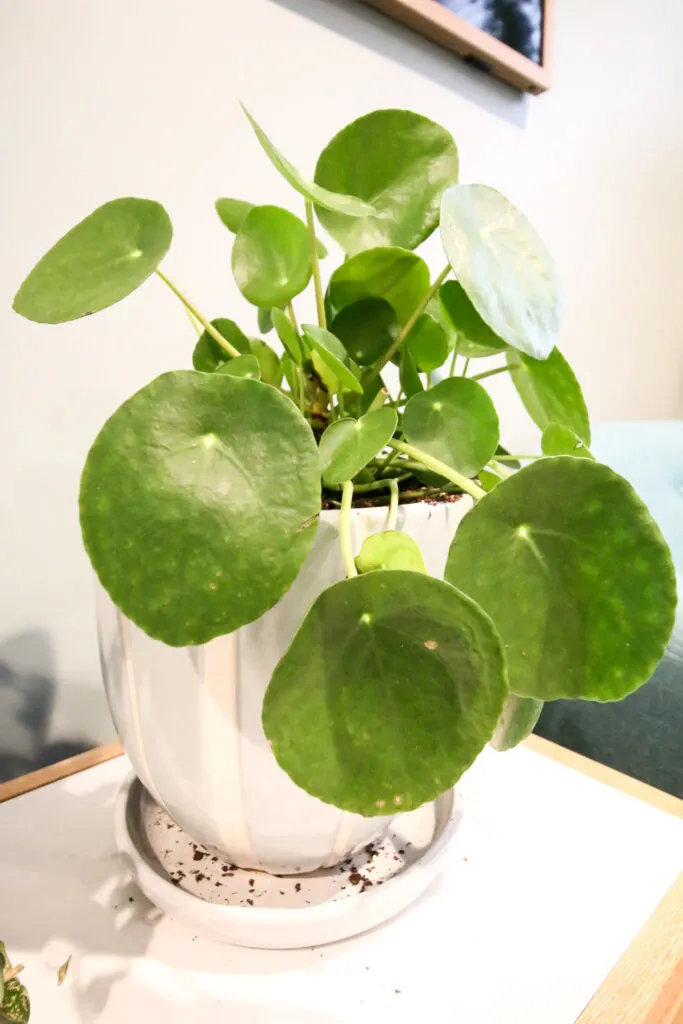
Is a Pilea a succulent?
No, pileas are not succulents! They have thick fleshy leaves but have very different needs compared to a succulent plant.
How long can a Pilea live?
These plants can live ten years or more if they are well cared for!
Is pilea toxic?
Pilea is generally non-toxic to pets and humans. As always, it’s best not to eat loads of it, so keep it away from hungry mouths.
Is pilea rare?
Pilea used to be rare in North America, but now it is widely available in nurseries. If I can find it at Lowes, it ain’t rare 😀
How fast does a pilea plant grow?
Pilea plants are very fast growing, especially in the spring and summer! If your plant isn’t growing, it’s probably not happy with its conditions.
More about Pilea plants
- Pilea care guide
- Pilea Dark Mystery Plant Care Guide
- How to propagate pilea from plantlets
- Why are my pilea leaves turning yellow?
- Common pilea peperomioides problems
- How to encourage pilea to grow pups
- What to do if your pet ate your pilea
- Why are my pilea peperomioides leaves curling?
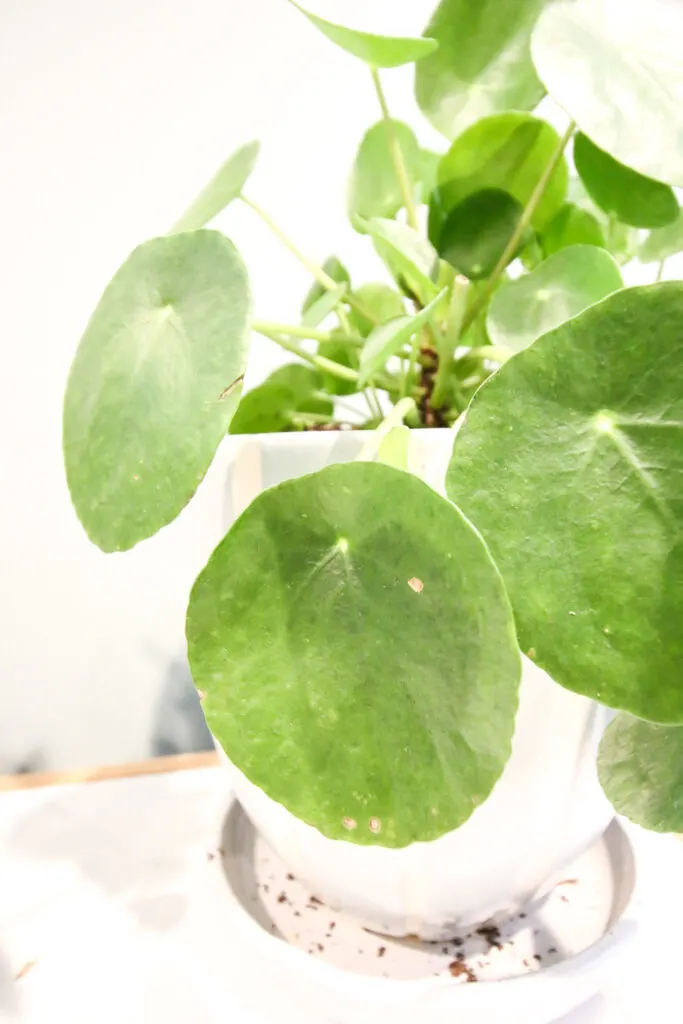
How to care for a pilea
Are Pilea easy to care for?
Pilea is a super easy to care for houseplant. It will tell you if something is wrong – respond quickly to keep it in tip top shape!
How much sun does a Pilea need?
Pilea does best in bright, indirect light. Direct sunlight can cause sunburn. Instead choose a window with bright light!
How often should you water a Pilea?
Water your pilea when the top 2 to 3 inches of soil are dry. Deep water the plant – meaning water it until water comes out of the drainage holes – once per week and it should stay happy.
Be sure that your pot has sufficient drainage – excess water can lead to root rot which will kill your pilea!
Also beware – plants in terracotta pots will need to be watered more often compared to plastic or ceramic pots! Just something to look out for!
Should I mist my Pilea?
Pilea Peperomioides humditiy needs are pretty simple and usually fine with household levels. However, they don’t mind being misted occasionally!
Be aware that getting any water drops on your plant’s leaves – including from misting – can leave water spots. These don’t hurt the plant and are just aesthetic.
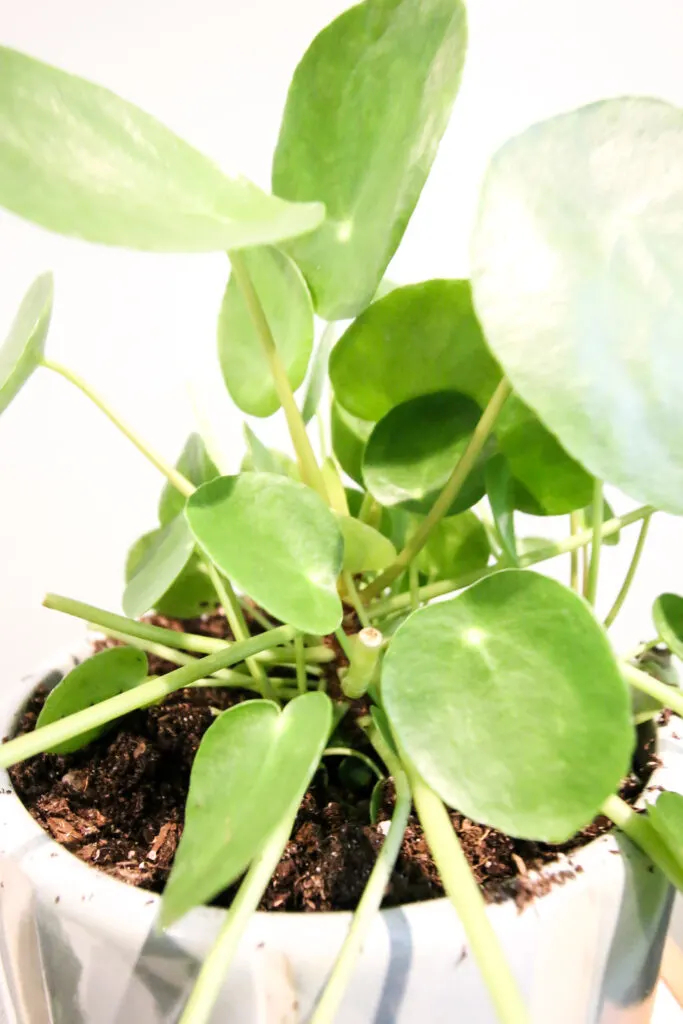
The best soil for a pilea
Pilea does well with soil that retains moisture. This usually means soil with coconut coir and Perlite.
Rotating your pilea
Pilea will grow towards the light, so it’s important to rotate it or risk a lopsided plant. I try to rotate my plants 1/4 turn when I water them. That’s an easy way to remember to do it!
Here’s my complete guide to rotating houseplants.
Cleaning your pilea’s leaves
Pilea’s big beautiful glossy green leaves can get dusty and dirty. Wipe them off periodically to keep them looking great and photosynthesizing well.
Here’s my guide to cleaning plant leaves!
Repotting a pilea
Repot your plant every 12-18 months. Choose a pot 1-2 inches larger to give it a bit of room to grow, but not too much space.
If you notice that your plant isn’t growing or isn’t producing babies, consider moving it to a larger pot to give it more growing room.
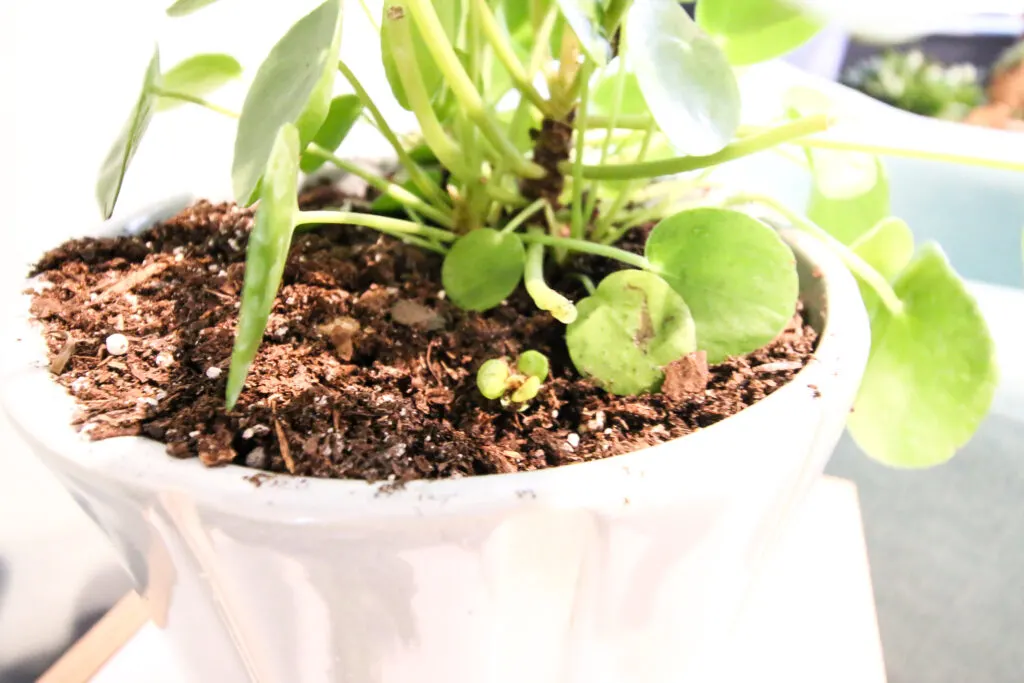
How to propagate a Pilea Peperomioides
It is easy to propagate a pilea is by plantlets. These plants put out lil babies that you can scoop up away from the mother plant and plant in their own pot! They will grow to a full plant you can share with your friends.
Here is my complete guide on how to propagate pilea!
How do you get Pilea babies?
The best way to get pilea babies is to make sure your plant is happy with proper light and watering.
you can remove the babies to make new plants, or leave them on the parent plant for a fuller, bushier look.
Common problems with pilea plants
Why are my Pilea leaves curling?
Leaf curling indicates that your plant is thirsty! Give it a drink to perk it back up.
Why is my pilea drooping?
Drooping leaves usually mean your plant needs more water. Give it a good watering and see if it perks up a bit!
It also could be that your plant is not getting enough light. Move it to a brighter spot and see if that helps!
Why does my pilea have yellow leaves?
If your plant’s lower leaves are turning yellow, it is likely due to overwatering. Be sure that your pot has plenty of drainage so the roots aren’t sitting in puddles. Only water when the soil feels dry.
Why are there brown spots on my pilea leaves?
Pilea leaves should be bright or dark green. Brown or black spots that are soft or mushy are a sign of root rot or overwatering. Let the plant dry out and be sure the pot has drainage holes.
If it’s very bad, you can pull the plant out and plant it in new soil.
Why are the new leaves on my pilea small?
New growth being small is a sign that your plant is not getting enough light! Move it to a sunnier spot!
Why does my pilea have white spots on the underside of the leaves?
These white spots are stomata. They come from a mineral residue left behind as water vapor is released through the pores of the leaf.
If you notice this a lot, you probably have a lot of chemicals or minerals in your water. Consider switching to rainwater or distilled water!
Any questions about Pilea Peperomioides Care?
Thanks for reading!


Hey there, I’m Morgan, a houseplant enthusiast from sunny Charleston, South Carolina. Growing up surrounded by my mom’s lush orchids and African violets, I discovered the magic of bringing nature indoors. Thanks to the pandemic, I delved deeper into houseplants, discovering their power to uplift moods and transform spaces. I’m here to spill all my secrets, helping you pick the perfect houseplant – and make it happy. Let’s keep your plants alive, together! 😊
